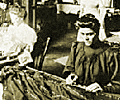










|
LESSON 3
Case Study:
The History of Mining in Cape Breton
Grade: 10
Time: one 72 minute class
Expectations:
Students will:
Knowledge
- produce an evaluation of the contributions to Canadian society by
its regional, linguistic, ethnocultural, and religious communities.
- explain how significant individuals contributed to the growing sense
of Canadian identity during World War I.
- assess the contributions of selected individuals to the development
of Canadian identity since World War I.
Skills
- use terms related to historical organization and inquiry correctly.
- formulate different types of questions.
- use computer-stored information and the Internet effectively to research
Canadian history topics.
- demonstrate competence in research and writing.
- express ideas and arguments in a coherent manner during discussions
and debates, or in graphic displays.
Preparation:
- locate and copy current labour and/or union related newspaper articles
- read about mind mapping in Program
Information Guide from The CRB Foundation We are Canadians
kit or in Teaching Guide from the CRB Foundation's Canadians
in the Global Community: War, Peace and Security, as it is a teaching
strategy suggested for this unit
- copy Suggested Topics: Newspaper
Article handout
- reserve computer time for class
- bookmark the Canada's Digital Collection The
History Mining in Cape Breton site
Lesson Plan:
- Collect recent articles about labour or union related news in Canada
and distribute copies to the students. The articles demonstrate to students
that labour and union issues remain important today, however, their dual
purpose is to discuss the characteristics of newspaper articles. After
allowing time to read the articles, ask students to co-operate and interact
with you to create a mind map describing the components of a newspaper
article (encourage students to refer to the examples).
Mind mapping is a visual presentation to summarize information. A typical
mind map is started by putting an image, word, or symbol in the centre
(i.e. Newspaper). Other images, words, or symbols are then added around
the centre with lines, arrows, or other visual devices (be creative) to
illustrate connections and relationships (see Program
Information Guide from The CRB Foundation We are Canadians
kit for more information about mind mapping).
- Build a list of common characteristics found in newspaper articles
as identified in the mind map. Ask students to copy the list of characteristics
for the second part of the lesson.
- Provide students with a brief introduction to The
History of Mining in Canada and on the east coast. Ask each student
(or pair of students) to complete the following assignment:
- pick from a topic from the Suggested Topics: Newspaper
Article handout
- browse the web site for information about the topic (encourage students
to read related information to understand the context of the topic)
- instruct students to complete a mind map for the topic expressing
their research and further questions they have generated
- instruct students to write a three paragraph (remind students to
recall expository paragraphs in Lesson 2) newspaper
article about the topic according to the criteria already established
- encourage students to have a partner edit each other's work and complete
the peer assessment part of the Suggested Rubric: Mind
Map and Newspaper Article
Possible Extensions:
- Try combining the articles as a magazine. It could be posted on
the Internet as a class project.
- Create a comparison organizer to contrast information found on both
the Canada's Digital Collection The
History Mining in Cape Breton and The
Cooperative Movement in Nova Scotia sites
- Visit the Canada's Digital Collection Young
Worker Awareness Program web site to discuss rights, duties, and hazards
of the workplace. Ask students to find examples in The
History Mining in Cape Breton site where the rights of workers according
to today's legislation were previously violated by employers.
Evaluation:
Informal:
- observe student work habits and participation during mind mapping
activity and group work time
Formal:
Bibliography
|
























